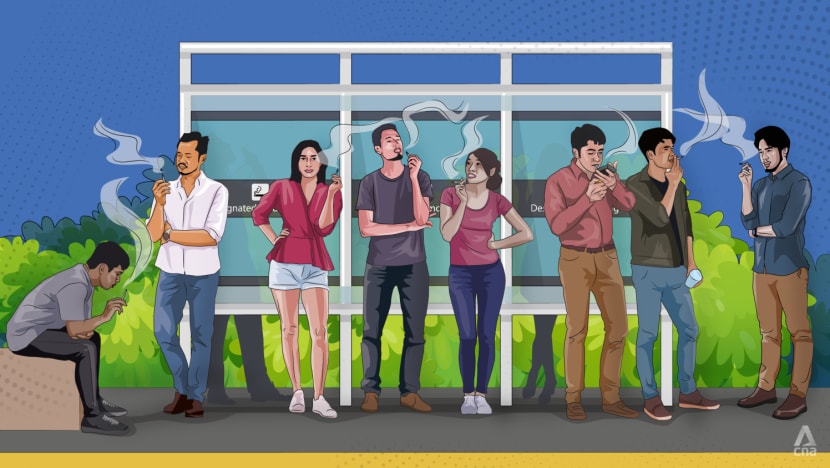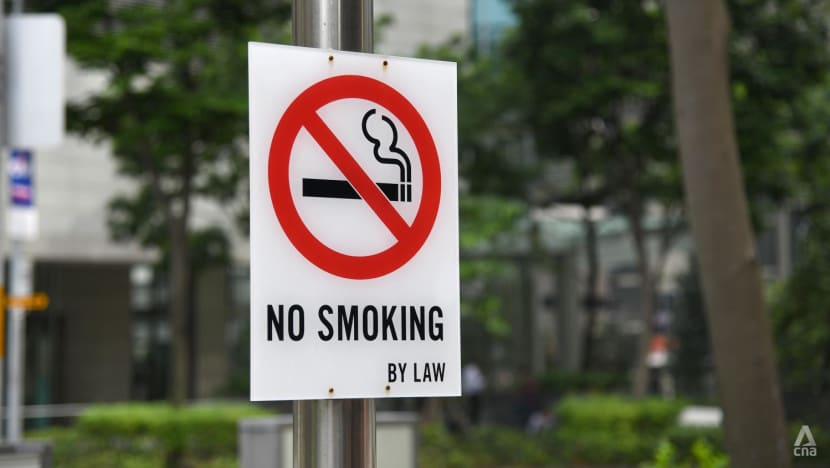IN FOCUS: Snuffing out smoking - is this the last mile in Singapore’s fight against tobacco?
Do tax hikes deter smoking and will banning future generations from smoking help to eradicate smoking in Singapore? CNA asks experts how Singapore can become a smoke-free nation.

(Illustration: Rafa Estrada)
SINGAPORE: Dozens of smokers were streaming in and out of a designated smoking area in Orchard Road on Monday (Feb 20), nearly a week after tobacco taxes went up 15 per cent.
A pack of cigarettes has gone up by about S$1.50 to S$2, but it wasn't stopping the smokers there.
Mr Steven Li, 35, who goes through half a pack of cigarettes a day, said that he’s tried to quit smoking twice but always went back to old habits.
When asked about the price hike and what might make him stop, he said in Mandarin: “I’ll smoke no matter how high the price (of cigarettes) is.”
Like many other smokers CNA spoke to, Mr Li said that he picked it up as a teen and he now smokes as a way of coping with stress. One former smoker, who has now turned to vaping, called it a form of “copium” - a portmanteau of “cope” and “opium”.
The higher prices do “pinch a bit”, said another smoker who asked not to be named. Those smoking a packet a day can spend more than S$300 a month on cigarettes, and a few told CNA they go through more than a pack a day, forking out about S$500 a month.
Some said they will try to cut down the amount they smoke, while others said they may switch to cheaper brands. But one smoker admitted that after a while, they “get used” to the higher prices.
The tobacco tax hike in the 2023 Budget was the third increase in cigarette prices in nine years. The 15 per cent hike is meant to discourage the consumption of tobacco products, Deputy Prime Minister and Finance Minister Lawrence Wong said on Feb 14.
The increase is expected to generate about S$100 million in additional tax revenue per year.
With this, every stick of cigarette is now taxed 49.1 cents, up from 42.7 cents. This means that a packet of 20 cigarettes that previously cost S$14 has gone up to S$15.52, said the Ministry of Finance (MOF).
The example is based on the approximate price of a pack of Marlboros, which is the most-sold brand of cigarettes in Singapore.
This move is the latest in a long list of initiatives targeting smokers. In addition to tax increases, more restrictions have been placed on where people can smoke. Last year, smoking bans were extended to public parks, recreational beaches and some water sites.
They were added to locations where a ban was already in place, such as shopping malls, bus stops and common areas in residential buildings.
When it comes to using prices as a way of discouraging smoking, in a World Health Organization (WHO) price list of the most sold brand of cigarettes in various countries from 2020, Singapore was among the most expensive places in the world to light up, trailing only Australia, New Zealand and pacific island nations like Nauru.
The excise tax incidence on the packet of cigarettes will be around 75 per cent before adding Goods & Services Tax, said MOF.
“This is comparable to countries such as New Zealand, France and Australia,” the ministry added.
It also meets the WHO recommendation that taxes should be at least 75 per cent of the retail price of the most popular brand of cigarettes.
DOES RAISING THE TOBACCO TAX WORK?
Do higher taxes and cigarette prices deter smokers? The short answer is: To some extent.
One former smoker, Jon Toh, said that he quit about five years ago when the tobacco tax was raised by 10 per cent in 2018.
Mr Toh, 43, said that back then he went to a convenience store to get a packet of cigarettes and realised that the price had gone up by about a dollar.
“The girl at the store told me that I will still smoke even if it’s more expensive,” he recounted. “I took that as a challenge.”
As it happened, he had no opportunity to smoke over the next three or four days, and that period of abstinence extended to five years, he said. It was his second attempt at quitting, after failing to do so once before.
He also said that he was in debt at the time, so the additional expense definitely gave him a push to kick the habit.
“The hike (in cigarette price) is too gradual, so people can adjust,” he said. “They can still afford it. They will get rid of the habit if they can’t afford it.”
Studies have shown that for every 10 per cent increase in real price, there will be about a 3 per cent to 5 per cent decrease in tobacco consumption, Senior Minister for Health Koh Poh Koon said in a parliamentary reply in January 2022.
The effect tends to be greater on people with the least to spend, including young people.
But tax increases need to keep pace with inflation if they are to have any effect, said Assistant Professor Yvette van der Eijk of the Saw Swee Hock School of Public Health.
“If the tax on a pack of cigarettes remains the same over time, but inflation causes the cost of living to increase, the tax becomes relatively less expensive in comparison to other goods and services,” said Assoc Prof van der Eijk.
“This can lead to a situation where the tax is not enough to deter people from buying cigarettes, and tobacco consumption may rebound.”
She thinks that tobacco taxes need to be frequent and sustained over time, and recommends that Singapore’s 15 per cent tax hike be repeated every year.
Which is why it may be more useful to look at affordability instead. Another WHO list measures affordability using the percentage of GDP per capita required to purchase 2,000 cigarettes of the most sold brand of cigarettes in the country.
This comparison, using 2020 prices, shows that despite the high absolute price of cigarettes in Singapore, they are more affordable here than in most countries.
A NATION OF NON-SMOKERS?
That’s not to say that Singapore’s efforts to snuff out smoking have been inadequate. On most WHO measures for tobacco control, the country does well.

Singapore has one of the lowest rates of smoking in the world and was once described by a tobacco company as ”the world’s most hostile environment” for the industry.
Smokers interviewed said that they are well aware of the harms of smoking, and have tried to, or want to quit.
Numbering about 10 per cent of the population, daily smokers are a small minority in Singapore. That’s half the global rate, according to WHO figures which show that in 2020, 22.3 per cent of the global population used tobacco.
The country has tried to curb smoking since the 1970s, and increasingly stricter measures have been imposed, resulting in one of the lowest rates of smoking in the world.
Tobacco Control Measures in Singapore
In 1970, Singapore was among the first countries to introduce a ban on smoking in certain public places. This has been expanded over the years to more and more areas, including most indoor spaces, hospital, schools and their surroundings, parks and playgrounds, washrooms and more.
In 1971, Singapore was the first Asian country to introduce a ban on tobacco advertisements in print, TV and radio. This advertising ban was extended in 1989 to prohibit free sampling, point-of-sale displays and the use of tobacco logos on non-tobacco products. In 2016, electronic tobacco advertisements were also banned.
In 1991, Singapore removed the duty-free tobacco allowance for all inbound travellers.
Two years later, a minimum legal age at which tobacco products can be purchased, set at 18 years old, was introduced.
In 1998, sales of tobacco products were restricted to licensed shops.
In 2004, Singapore became the first Asian country to introduce mandatory graphic health warning labels on tobacco product packaging. This followed earlier requirements that cigarette packets carry text health warning labels.
In 2017, Singapore implemented a point-of-sale display ban for tobacco products and banned the purchase, use and possession of imitation tobacco products.
From 2019, Singapore progressively raised the minimum legal age at which tobacco products can be purchased from 18 years to 21 years of age.
That year, Orchard Road was made a no-smoking zone, and you can only smoke at designated areas.
Since Jul 1, 2020, all tobacco has had to come in standardised packaging.
Sources: Public Consultation Paper on Proposed Tobacco Control Measures in Singapore 2018, Ministry of Health, Health Promotion Board
The daily smoking prevalence rate has seen a gradual but steady downtrend. It was 18.3 per cent in 1992, and hovered at 12 to 14 per cent for many years from 2004 to 2017. Then fell to 10.6 in 2019, dipping further to 10.1 per cent in 2020. The rate then went up slightly to 10.4 per cent in 2021.
That is just shy of a target the Health Ministry had set in 2018, to reduce the smoking rate to below 10 per cent by 2020.
In recent years, the smoking age has been raised from 18 to 21, and smoking has been banned in more public spaces. Tobacco is now required to come in standardised packaging, with no shop displays or ads allowed.
These measures are in addition to campaigns and programmes by health authorities to discourage smoking and help smokers quit.
Yet, many smokers feel that they can’t stop. A few younger smokers that CNA spoke to said that they bought cigarettes on trips to Johor Bahru, where it’s much cheaper, or have now switched to vaping, despite it being illegal.
Interviewees shared how they put on weight, had bad withdrawal symptoms, or succumbed to stress or peer pressure when they tried to quit.

Older smokers, meanwhile, seemed resigned to smoking their whole life, with one saying that he has switched to rolled tobacco, which is much cheaper, to sustain the habit.
Mr Ang Keng Keong, 55, who started smoking at 12, said that he switches to a cheaper brand each time the prices are raised.
“I’ve been smoking for 40 over years, I can’t quit. How to quit? I don’t know,” he said in Mandarin.
WHY IT CAN BE HARD TO QUIT
Smoking is intrinsically addictive due primarily to the nicotine found in cigarette smoke, said Dr Lambert Low, deputy chief at the Department of Addiction Medicine, Institute of Mental Health.
“Nicotine is one of the most addictive chemicals on our planet and has even been compared to heroin and cocaine in terms of its addictive potential,” he said.
“Many patients who have recovered successfully from their drug addiction have found it quite hard to stop smoking despite having quit their drug or alcohol addiction.”
He explained that nicotine reaches the brain within seconds of a person smoking and leads to dopamine - the “feel good” chemical - being released.
The dopamine triggers a “positive feedback loop” that is reinforced whenever a person smokes.
“Over time, this then causes our brain’s reward pathway to be hijacked, leading to an addiction,” said Dr Low.
Other than nicotine, cigarette smoke contains thousands of chemicals, many of which cause cancer, heart disease, lung disease, or other serious health problems.
Once a person has started smoking and developed an addiction, combining behavioural approaches with medication or nicotine replacement therapy would be the best option to help a smoker quit the habit, he said, adding that the success rate of treatment varies and relapse rates are high, advised Dr Low.
"Most people who smoke already know how bad it is for their health, their wallets and the people around them, yet they can't stop. There is no one method to get people to stop smoking."
The best option would be to prevent a person from smoking in the first place, he said.
WHAT ELSE CAN SINGAPORE DO?
One proposal that has popped up is a cohort or generational ban on smoking - meaning that everyone under a certain age - say, 21 - will be banned from smoking forever.
Members of Parliament here have raised it in the House more than once, particularly after New Zealand announced plans to implement it.
Last December, it became the first country in the world to pass such a law. From 2023, tobacco cannot be sold in New Zealand to anyone born on or after Jan 1 2009, or currently aged 14 and below.
The new law also slashes the number of retailers licensed to sell tobacco, from 6,000 to 600 by the end of 2023, and will reduce the amount of nicotine allowed in tobacco products, reports said. However, unlike Singapore, the country has not banned vaping.
Other countries, including Malaysia and Denmark, also plan to introduce such tobacco bans.
Mr Louis Ng (PAP-Nee Soon), one MP who has campaigned vociferously against smoking and second-hand smoke, said: “I think a generational ban strikes a good balance and takes into account the concerns of current smokers who may want to continue to smoke.
“I do believe the generational ban will be our most effective and direct measure to reduce smoking rates in Singapore.”
Depending on the degree of implementation, a generational ban can involve making it illegal for people born in a certain year to buy or consume tobacco products.
Mr Ng said that he’s “optimistic” this will eventually be implemented.
In January, Senior Parliamentary Secretary for Health Rahayu Mahzam said that the Health Ministry is studying whether New Zealand’s implementation approach is feasible in Singapore.
Answering questions from MPs, she said: “We are not closing our minds to this. In fact, we are reviewing it but we are also learning to see how it is going to be effective in our context.”
One consideration is that the ban in New Zealand will be limited to retail sales to young people 14 and below, so they will still be able to smoke cigarettes that are given to them by others.
Ms Rahayu said that for a ban to be completely effective, Singapore needs to introduce laws to penalise older people who are not subject to the ban but who may be abetting or supplying the products.
“We already have many measures in place. As with everything, we want to make sure that it is effective because it is also the implementation, the resources that we have to put in,” she said.
“As it stands, we are already constantly reviewing, constantly taking in feedback from partners that we are working with to see how best we can implement this.”
Assoc Prof van der Eijk said that a generational phase-out of tobacco sales is definitely feasible here, as Singapore, like New Zealand, already has a strong anti-tobacco climate.
The main factor to consider is that it takes a long time to take effect, as only impacts youths. Thus, it is important to complement it with other tobacco measures that bring down smoking rates in the short term, such as taxes, better quit services and a tobacco flavours ban, she said.
“In addition, the idea of a tobacco-free generation originally came from Singapore and, as early as back in the early 2010s, early polls indicated strong public support for this proposal in Singapore,” said the associate professor.
“Our own research shows that, in Singapore, it would effectively reduce smoking to near-zero levels although this would take some time - around four decades.”























